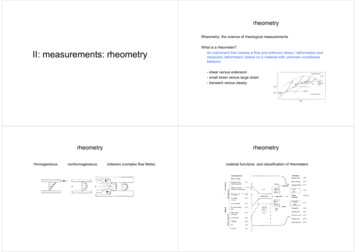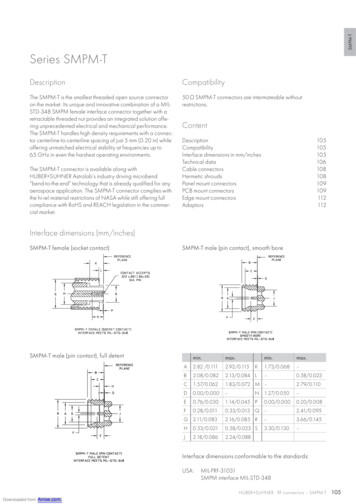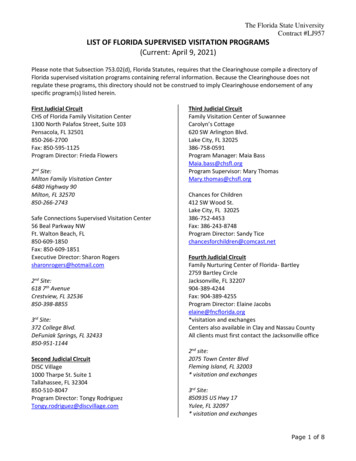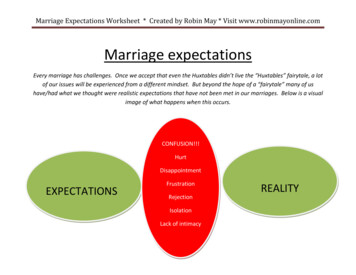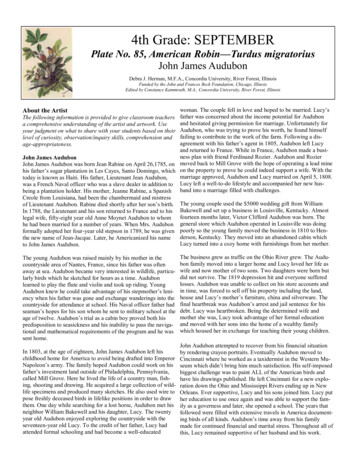
Transcription
4th Grade: SEPTEMBERPlate No. 85, American Robin—Turdus migratoriusJohn James AudubonDebra J. Herman, M.F.A., Concordia University, River Forest, IllinoisFunded by the John and Frances Beck Foundation, Chicago, IllinoisEdited by Constance Kammrath, M.A., Concordia University, River Forest, Illinoiswoman. The couple fell in love and hoped to be married. Lucy’sfather was concerned about the income potential for Audubonand hesitated giving permission for marriage. Unfortunately forAudubon, who was trying to prove his worth, he found himselffailing to contribute to the work of the farm. Following a disagreement with his father’s agent in 1805, Audubon left Lucyand returned to France. While in France, Audubon made a business plan with friend Ferdinand Rozier. Audubon and RozierJohn James AudubonJohn James Audubon was born Jean Rabine on April 26,1785, on moved back to Mill Grove with the hope of operating a lead minehis father’s sugar plantation in Les Cayes, Santo Domingo, which on the property to prove he could indeed support a wife. With themarriage approved, Audubon and Lucy married on April 5, 1808.today is known as Haiti. His father, Lieutenant Jean Audubon,was a French Naval officer who was a slave dealer in addition to Lucy left a well-to-do lifestyle and accompanied her new husbeing a plantation holder. His mother, Jeanne Rabine, a Spanish band into a marriage filled with challenges.Creole from Louisiana, had been the chambermaid and mistressof Lieutenant Audubon. Rabine died shortly after her son’s birth. The young couple used the 5000 wedding gift from WilliamIn 1788, the Lieutenant and his son returned to France and to his Bakewell and set up a business in Louisville, Kentucky. Almostfourteen months later, Victor Clifford Audubon was born. Thelegal wife, fifty-eight year old Anne Moynet Audubon to whomhe had been married for a number of years. When Mrs. Audubon general store which Audubon operated in Louisville was doingformally adopted her four-year old stepson in 1789, he was given poorly so the young family moved the business in 1810 to Henderson, Kentucky. They moved into an abandoned cabin whichthe new name of Jean-Jacque. Later, he Americanized his nameLucy turned into a cozy home with furnishings from her mother.to John James Audubon.About the ArtistThe following information is provided to give classroom teachersa comprehensive understanding of the artist and artwork. Useyour judgment on what to share with your students based on theirlevel of curiosity, observation/inquiry skills, comprehension andage-appropriateness.The young Audubon was raised mainly by his mother in thecountryside area of Nantes, France, since his father was oftenaway at sea. Audubon became very interested in wildlife, particularly birds which he sketched for hours as a time. Audubonlearned to play the flute and violin and took up riding. YoungAudubon knew he could take advantage of his stepmother’s leniency when his father was gone and exchange wanderings into thecountryside for attendance at school. His Naval officer father hadseaman’s hopes for his son whom he sent to military school at theage of twelve. Audubon’s trial as a cabin boy proved both hispredisposition to seasickness and his inability to pass the navigational and mathematical requirements of the program and he wassent home.In 1803, at the age of eighteen, John James Audubon left hischildhood home for America to avoid being drafted into EmperorNapoleon’s army. The family hoped Audubon could work on hisfather’s investment land outside of Philadelphia, Pennsylvania,called Mill Grove. Here he lived the life of a country man, fishing, shooting and drawing. He acquired a large collection of wildlife specimens and produced many sketches. He also used wire topose freshly deceased birds in lifelike positions in order to drawthem. One day while searching for a lost horse, Audubon met hisneighbor William Bakewell and his daughter, Lucy. The twentyyear old Audubon enjoyed exploring the countryside with theseventeen-year old Lucy. To the credit of her father, Lucy hadattended formal schooling and had become a well-educatedThe business grew as traffic on the Ohio River grew. The Audubon family moved into a larger home and Lucy loved her life aswife and now mother of two sons. Two daughters were born butdid not survive. The 1819 depression hit and everyone sufferedlosses. Audubon was unable to collect on his store accounts andin time, was forced to sell off his property including the land,house and Lucy’s mother’s furniture, china and silverware. Thefinal heartbreak was Audubon’s arrest and jail sentence for hisdebt. Lucy was heartbroken. Being the determined wife andmother she was, Lucy took advantage of her formal educationand moved with her sons into the home of a wealthy familywhich housed her in exchange for teaching their young children.John Audubon attempted to recover from his financial situationby rendering crayon portraits. Eventually Audubon moved toCincinnati where he worked as a taxidermist in the Western Museum which didn’t bring him much satisfaction. His self-imposedbiggest challenge was to paint ALL of the American birds andhave his drawings published. He left Cincinnati for a new exploration down the Ohio and Mississippi Rivers ending up in NewOrleans. Ever supportive, Lucy and his sons joined him. Lucy puther education to use once again and was able to support the family as a governess and later, she opened a school. The years thatfollowed were filled with extensive travels in America documenting birds of all kinds. Audubon’s time away from his familymade for continued financial and marital stress. Throughout all ofthis, Lucy remained supportive of her husband and his work.
Discipline-Based Art EducationThe following components are integral to students having a complete, well rounded artexperience.Art AestheticsProviding opportunities to develop perception and appreciation of visually expressedideas and experiences.Art ProductionProviding opportunities to develop skills andtechniques for creative visual expressions ofemotions and ideas.Art HistoryProviding opportunities to develop an understanding of the visual arts as a basic component of personal heritage.Art CriticismProviding an opportunity to develop anintellectual basis for analyzing and makingaesthetic judgments based on an understanding of visual ideas and experiences.ELEMENTS OF ARTLine: A continuous markShape: Area enclosed by a lineColor: Hue, reflection of light.Texture: Surface quality, real or impliedForm: 3D shape or illusion of 3DValue: Graduated areas of light/darkSpace: Illusion of depthPRINCIPLES OF DESIGNRepetition: Imagery repeating patternVariety: Contrast/variationRhythm: Issues of eye movementBalance: Even visual weightEmphasis/Economy: Dominance/minimalismProportion: Compare size relationshipsCOMPOSITIONSymmetrical: Mirrored imageryAsymmetrical: Random placementRadial: Mirror image from center pointRepetition: Repeating pattern, motifARTISTIC STYLESRealism: Realistic representationAbstraction: Personal interpretationNon-Objective: No recognizable depictionELEMENTS OF DESIGN IN PICTUREBOOKSChildren’s literature that relate to this lessondue to elements of art or story content are:Boy Who Drew Birds: A Story of JohnJames Audubon by Jacqueline DaviesBackyard Bird Watching for Kids by GeorgeH. Harrison and Kit HarrisonCapturing Nature: The Writings and Art ofJohn James Audubon edited by Peter andConnir RoopInto the Woods: John James Audubon LivesHis Dream by Robert BurleighJohn James Audubon by Joseph KastnerJohn James Audubon: Wildlife Artist byPeter AndersonREFERENCE/BIBLIOGRAPHYRhodes, Richard. John James Audubon,The Making of an American. Knopf. NY2004Stokstad, Marilyn. Art History, Volume Two.Harry Abrams. NY. 1995In 1824 Audubon traveled to Philadelphia tofind a publisher for his collection of birddrawings. After a second refusal Audubonrealized the only chance to get his book published in England where he would find greaterinterest. In order to raise the money for such atrip, Audubon exhibited his bird paintings,solicited subscriptions from patrons and Lucysaved her earnings. Once in London, Audubonreached an agreement with an engraver and in1827, the dream of Birds of America, complete with four hundred thirty-five handcolored and life-sized prints made from copper plates became a reality. The book waswell accepted and brought Audubon fame andcredibility as the foremost naturalist of America, no easy feat since he had no formal scientific training. He devoted about ten years tothis publication process and the serial publications, including a text commentary. The laststage of his project was to prepare a miniatureversion of the folio which he completed inAmerica between 1842 and 1845. He alsobegan a few more projects such as ViviparousQuadrupeds of North America but his healthbegan to fail and the book was completed byhis son.painted to show the variations. Audubon began with building up layers of watercolorpaint and added colored chalk to give thework depth.Directed ObservationShow students an image of American Robinand tell them it was painted by John JamesAudubon. Invite students to quietly study thework. After some time for thinking, encouragestudents to share what they see. Welcome allcomments. The following questions are provided to help students use art vocabulary totalk about the work.1. Audubon worked very hard to completehis project. He risked financial stabilityand left his family for long periods oftime. Sometimes, artists make sacrificesto do what they love. What do you enjoydoing and what sacrifices do you make?2. Discuss the sacrifices Lucy Audubonmade to support her husband. What doher sacrifices tell you about her character?3. Audubon ventured into many parts ofAmerica to locate and paint birds. Discussthe various places he might have explored. Would you like his job?4. This painting was created for a specificFinally experiencing financial success, thepurpose—to educate people about theAudubons bought an estate in New York onAmerican robin. What does the artistthe Hudson River. Audubon settled into a lifewant you to know about the robin? Howwhich included time to advise young sciendoes he teach you?tists. Audubon suffered a stroke in January of 5. Discuss the various textures, colors,1851 which affected his mental competencyshapes and lines in this painting.and left him partially paralyzed. He died at the 6. Some art is made from imagination, othfamily home on January 27 at the age of sixtyers replicate exactly what is seen asfive. His place of burial is unclear but manyAudubon did. Which do you like better?think he was buried in Trinity Churchyard7. As an artist, what would you like to paintCemetery in Manhattan, New York.to educate others?His estate was left in the hands of his sons.Things to DoUnfortunately, poor business planning re1. Visit a field museum in your communitysulted in the loss of financial security. Theand view the bird wildlife exhibit. Choosesituation forced Lucy at age fifty-eight to reyour favorite and render sketches fromturn to teaching for the next ten years. Lucydifferent vantage points. Make a finalBakewell Audubon died in 1874 at the age ofrendering in color.eighty-seven. In 1886, a former student of2. Study the other works of Audubon toLucy named George Bird Grinnell foundedlearn his techniques. Then use yourthe Audubon Society dedicated to the conserimagination to create a new bird, perhapsvation and restoration of ecosystems, focusinga combination of two existing birds. Drawon birds and other wildlife.a male, female and young bird in theirhabitat. When complete, name your birdAbout the Artand bind your page with others to create aAmerican Robin was painted by John Jamesbook to share.Audubon for his collection of Birds of Amer- 3. Use your sketches to create a 3D form ofica. Audubon remarked the first time he sawthe bird. Use a plaster and paper macheand heard the robin, he was moved to tears bymix over an armature. Paint when dry.its beautiful song. In general, Audubon basedMount your bird on a platform or a treehis paintings on the direct observations whichbranch.he sketched. He depicted his birds in a true-to- 4. If you have access to a kiln, create a birdlife habitat and in motion, which was new tofrom ceramic clay.his patrons. Both male and female birds were 5. Write a story from a bird’s perspective.
4th Grade: OCTOBERWallpaper & Patterned FabricWilliam MorrisDebra J. Herman, M.F.A., Concordia University, River Forest, IllinoisFunded by the John and Frances Beck Foundation, Chicago, IllinoisEdited by Constance Kammrath, M.A., Concordia University, River Forest, IllinoisAbout the ArtistThe following information is provided to give classroom teachersa comprehensive understanding of the artist and artwork. Useyour judgment on what to share with your students based on theirlevel of curiosity, observation/inquiry skills, comprehension andage-appropriateness.house in Bexley Heath just outside London and named it “RedHouse.” Morris searched for beautiful furniture and textiles forhis new home, but unable to find anything that met his high standards, he designed his own furniture and textiles.Jane Burden had had a very modest upbringing without the opportunity to attend school. During her marriage to Morris however, Jane blossomed into a self-taught intellectual and discovWilliam MorrisWilliam Morris was born the eldest of nine children on his fam- ered and developed her artistic talent. Her striking beauty madeily’s estate, “Elm House,” located in Walthamstow, Greater Lon- her a natural model for several artists of the time. Two daughtersdon, England, on March 24, 1834. His father was a very success- were born to this union, Jenny and May.ful businessman and provided a luxurious lifestyle for his familymaking Morris a spoiled and temperamental child. People noted Two year after his marriage, William Morris founded a decorative arts firm with several partners, Edward Burne-Jones andhis ability to read novels at an early age, and his interest in medieval fantasy and botany by the age of five. Young Morris spent Philip Webb among them. Partners came and went and the business changed names often. In the end, the “Morris & Company”childhood days playing in the nearby Epping Forest which inspired his love of nature. He was known to walk every path gaz- name was most well-known and carried a reputation for the highest standards for its decorative arts products, first intended foring at the foliage. His second childhood home on fifty acres inEssex additionally fed Morris’ interest in gardening and the great churches and then later broadened to include homes. Morris hadoutdoors. Into adulthood, Morris could recall images of plant life an exceptional affinity for textiles. He taught himself embroideryin great detail. He first studied with his sister’s governess before and trained others including his wife. His business designed patterns used in its finished embroidered and woven textiles andhis more formal education. When Morris was a teenager, his fawallpaper made with a woodblock printing process. Williamther died, forcing the family to move to a smaller house.Morris is credited with resurrecting nearly-lost techniques ofWilliam Morris began his college career at Marlborough College, printing, weaving, and dying processes. Many of his patterns inattending for three years. Later, he entered Exeter College in Ox- wallpaper and textiles are still popular today.ford in 1853 with the plan of becoming a priest. This goal wasOne characteristic of William Morris’ designs was the subjectabandoned for renunciation of the church after he read socialmatter of nature such as flowers, vines, leaves, fruits, andcommentaries on the Church. While at Exeter College, Morrisbranches. In the midst of the Industrial Revolution, Morris wasmet Edward Burne-Jones, who would become both a life-longfriend and business partner. Prompted by Morris, the team began persistent in designs which brought nature and its beauty into theto define their design philosophy shifting from the manufactured home, whether in stained glass, wallpaper, or textiles.decorative arts of the time towards a renewed sensitivity to natureand the belief that one should live in beauty and have a regard for During his lifetime, William Morris continued to write poemsand short stories as well as translating many medieval and classicraftspeople as artists. Morris also dabbled in poetry and pubcal works. In time, his strict work ethic and pursuit of perfectionlished his prose and short stories in the Oxford and Cambridgebegan to undermine his health. Morris suffered a severe attack ofMagazine which he founded and financed.gout in the spring of 1891 followed by deteriorating healthcaused by diabetes, tuberculosis and kidney problems. MorrisMorris graduated from Oxford in 1856 and took a job with theLondon-based architect, G.E. Street, who specialized in reviving was eventually confined to his home with lung congestion,tended by family and friends. After Morris died October 3, 1896,the English Gothic style. During this apprenticeship, Morrisshifted his attention away from architecture toward the decorative at the age of sixty-two, he was buried in a plain oak coffin covarts. Decorative arts included those art forms for decorating inte- ered with an antique brocade cloth. The funeral took place duringa drenching rainstorm. His tombstone was designed by partnerrior environments of homes and churches, including everythingfrom textiles to wallpaper to stained-glass windows and carpets. and friend Philip Webb.Twenty-five year old Morris married the beautiful Jane BurdenAbout the Arton April 16, 1859. As a wedding gift to his new bride, Morris and Wandle Chintz was a fabric designed by William Morris in 1883his architecture, Philip Webb, designed and built a beautiful1884. The Wandle Chintz pattern was named after and inspired
Discipline-Based Art EducationThe following components are integral to students having a complete, well rounded artexperience.Art AestheticsProviding opportunities to develop perception and appreciation of visually expressedideas and experiences.Art ProductionProviding opportunities to develop skills andtechniques for creative visual expressions ofemotions and ideas.Art HistoryProviding opportunities to develop an understanding of the visual arts as a basic component of personal heritage.Art CriticismProviding an opportunity to develop anintellectual basis for analyzing and makingaesthetic judgments based on an understanding of visual ideas and experiences.ELEMENTS OF ARTLine: A continuous markShape: Area enclosed by a lineColor: Hue, reflection of light.Texture: Surface quality, real or impliedForm: 3D shape or illusion of 3DValue: Graduated areas of light/darkSpace: Illusion of depthPRINCIPLES OF DESIGNRepetition: Imagery repeating patternVariety: Contrast/variationRhythm: Issues of eye movementBalance: Even visual weightEmphasis/Economy: Dominance/minimalismProportion: Compare size relationshipsCOMPOSITIONSymmetrical: Mirrored imageryAsymmetrical: Random placementRadial: Mirror image from center pointRepetition: Repeating pattern, motifARTISTIC STYLESRealism: Realistic representationAbstraction: Personal interpretationNon-Objective: No recognizable depictionELEMENTS OF DESIGN IN PICTUREBOOKSChildren’s literature that relate to this lessondue to elements of art or story content are:American Book Design and William Morrisby Susan Otis ThompsonRepeat Pattern: A Manual for Designers,Artists and Architects by Peter PhillipsThe Wild Swans by Hans Christian AndersenWilliam Morris Full-Color Patterns andDesigns (Pictorial Archives) by WilliamMorrisWilliam Morris and Red House, Jan MarshREFERENCE/BIBLIOGRAPHYParry, Linda. William Morris. Harry N.Abrams. 1996Jill, Duchess of Hamilton, Penny Hart andJohn Simmons. The Gardens of WilliamMorris. Steward, Tabori & Chang. NY. 1998Van der Post, Lucia and Linda Parry. William Morris and Morris & Co. Victoria &Albert Museum. 2003by the River Wandle, a tributary of theThames in southwest London flowing pastWilliam Morris’ business. Wanting to bringhonor to the river, Morris created the design.2.3.Frequently used for upholstery, chintz is astrong cotton fabric glazed with a printed pattern.Directed Observation4.Show students an image of Wandle Chintz andtell them it was designed by William Morrisand printed in his textile studio. Invite students to quietly study the work. After sometime for thinking, encourage students to sharewhat they see. Welcome all comments. Thefollowing questions are provided to help students use art vocabulary to talk about thework.1. Identify what makes a pattern. Spend afew minutes and locate patterns you seein your classroom. Look at patterns inyour clothing. Identify patterns in plantlife, animal life, music, dance, weather,behavior.2. Why are patterns important? Transitionthe discussion to patterns used in thedecorative arts of William Morris.3. Look at the layers in the Wandle Chintzfabric design. Discuss the background,mid-ground and foreground and the role5.each layer plays in the design.4. Since this design was inspired by theRiver Wandle, discuss the many ways thisdesign reminds you of a river.6.5. Look carefully and identify where thepattern on one section meets and contin7.ues onto the next section. Be sure to lookon both sides, top and bottom. Patternsare repeated images and there are manylayout options for creating patterns, including a random pattern possibility.6. Look closely at pattern printed on textilesor an old wallpaper book and identifyhow and where the patterns are repeated.7. Discuss the following William Morrisquote and relate it to how he lived his life:“Have nothing in your houses that you donot know to be useful, or believe to bebeautiful.” (The Beauty of Life, 1880).Things to Do1.Printing on paper or fabric is a fun andcreative process. For starters, developyour skill as a pattern designer. On a prepared handout with several exact 2”x 2”squares on it, freely draw a different pattern with lines and shapes. Considerdrawing patterns mentioned in #1 above.Duplicate your designs with a copy machine. Cut the duplicated squares out andplace patterns side by side. Observe thenew pattern that emerges when onesquare lines up against another square.Draw patterns you see in nature.You can repeat the process using differentgeometric shapes and/or varying theplacement of your shapes as illustratedbelow. Make many copies of a design andpaste them on a large poster board or bulletin board paper.For a more sophisticated process, try designing a stamp. This can be done using aStyrofoam sheet such as one used in meatpackaging. Commercial sheets can bepurchased at crafts stores. Use a pencil orballpoint pen to press into the foam causing a depression in the surface. You canalso cut compressed sponges or half potatoes into shapes. An adult can cut awayportions of the potato’s surface to create adesign. Set potato aside. Spread printingink, available at crafts stores, on a cookiesheet or other flat surface with a brayeruntil tacky. Roll the inked brayer over thesurface of the Styrofoam sheet, sponge orpotato to transfer the ink. Then press thesurface onto paper. You can also pressthe potato or sponge directly onto theflattened ink and then repeatedly print onpaper to create a pattern. See printed pattern below.Find items which have interesting textures, such as leaves, the tines of a fork orbottom of a cup. Press these found objectsinto printing ink and print on paper.Choose two ink colors and two differentshapes. Print in an alternating pattern.Print a repeated design on a 12” x 18”piece of construction paper. When dry,laminate and use as a placemat.
4th Grade: NOVEMBERDignity and ImpudenceSir Edwin Henry LandseerDebra J. Herman, M.F.A., Concordia University, River Forest, IllinoisFunded by the John and Frances Beck Foundation, Chicago, IllinoisEdited by Constance Kammrath, M.A., Concordia University, River Forest, IllinoisAbout the ArtistThe following information is provided to give classroom teachersa comprehensive understanding of the artist and artwork. Useyour judgment on what to share with your students based on theirlevel of curiosity, observation/inquiry skills, comprehension andage-appropriateness.Sir Edwin Henry LandseerEdwin Henry Landseer was born March 7, 1802, to John Landseer and Miss Potts in London, England. John Landseer was anengraver who had a great love for art, especially art that usedprecious metals. Miss Potts was also artistic and served as amodel for famous painters including Sir Joshua Reynolds. Edwinwas the third son born into the family of seven children. His twobrothers grew up to be artists, too.All the Landseer children were encouraged by their parents todraw the landscape around their Hampstead home. The youngchildren often sat in the grass and sketched the sheep, rabbits,goats, cows, dogs and even donkeys on their property. Even atthe young age of four, Landseer was able to distinguish the various physical characteristics of each animal and draw them accordingly, even better than his older siblings! His father, John,was aware of his young son’s extraordinary artistic gifts and preserved his early sketches which can be viewed today at the SouthKensington Museum in London.poor to afford a work of Edwin Landseer. The best way to accomplish this was by creating etchings of his work. His fatherJohn and brother Thomas led the way for mass producingEdwin’s drawings. It soon became commonplace for most household to have an Edwin Landseer etching.Wealthy people approached Landseer to paint their beloved dogs.So common was this request that a painting studio was eventuallyopened where owner and dog could pose. With his popularity andreputation growing, Landseer was invited to exhibit his works atthe Royal Academy. Subsequent distinction brought financialsuccess and elevated status. Landseer became a regular exhibitorat the Royal Academy and was voted an associate member at theage of twenty-four.Payments from Edwin Landseer’s commissions gave him thefinancial stability to purchase his own home in the St. John’sWoods area of London, a small house which he enlarged frequently as funding permitted. The property had a barn Landseerconverted into his studio. The new home was filled with dogsincluding Landseer’s favorite staghound, Maida. To honor thisdog, Landseer named the home Maida Villa. The villa became asocializing location for the wealthy of London and people feltprivileged to receive an invitation to Landseer’s home.Edwin Landseer was fortunate to be introduced to Victoria,Queen of England. Their discussions were focused on their mutual love of dogs and horses. In no time they became goodOne exhibition witnessed by the Landseer children was of a female Newfoundland dog who rescued and cared for an orphaned friends. In addition to riding with Queen Victoria, Prince Albertlion cub. The nurturing relationship continued even when the cub and other members of the royal family, Landseer painted many ofthe royal dogs and horses as well as portraits of the queen andhad grown twice the size of its stepmother. The Landseer boysprince alongside their favorite pets. His paintings of the royalspent hours observing this odd relationship sketching the manyfamily and their beloved animals began in 1835 and earned himactions of the grown cub and maternal dog.over 250,000. Today, over one-hundred Landseer paintingsA move to a new home near Burlington House gave the Landseer commissioned by Queen Victoria hang in the National Academy.brothers an opportunity to care for many dogs. It was here thatEdwin Landseer really learned to love dogs. He noticed that their The number of commissions Edwin Landseer took on was overdiffering temperaments, emotions and relationships held the same whelming. The waiting list of those who sought an original painting was years out. In time, the pressure of keeping up his profescharacteristics as humans!sion as well as his social obligations took its toll. In the lateThe three Landseer brothers took lessons from Benjamin Robert 1830s, Landseer suffered a severe nervous breakdown. He subsequently suffered from depression and hypochondria. Despite hisHaydon when he opened an art school in 1815. Haydon encouraged the young brothers to study animal anatomy through dissec- personal struggles, Landseer continued to execute paintings withtion to help the boys understand the muscle structure of their sub- his usual high standards and was rewarded for his artistic effortsjects. With this skill in hand, Edwin Landseer began painting his in 1850 when he was knighted. In the later years of his life, SirEdwin Henry Landseer’s condition worsened. In 1872, at the agebeloved animals with even more precision. It was rumored heof seventy, his family requested Landseer be declared insane.could even paint with a paintbrush in both hands at the sametime. His work became very popular with the public. A decision Sir Edwin Landseer died on October 1, 1873, at the age of sevwas made by the Landseer family to make it possible for even the enty-one in London. In appropriate response to hearing about the
Discipline-Based Art EducationThe following components are integral to students having a complete, well rounded artexperience.Art AestheticsProviding opportunities to develop perception and appreciation of visually expressedideas and experiences.Art ProductionProviding opportunities to develop skills andtechniques for creative visual expressions ofemotions and ideas.Art HistoryProviding opportunities to develop an understanding of the visual arts as a basic component of personal heritage.Art CriticismProviding an opportunity to develop anintellectual basis for analyzing and makingaesthetic judgments based on an understanding of visual ideas and experiences.ELEMENTS OF ARTLine: A continuous markSh
the bird. Use a plaster and paper mache mix over an armature. Paint when dry. Mount your bird on a platform or a tree branch. 4. If you have access to a kiln, create a bird from ceramic clay. 5. Write a story from a bird’s perspective. Discipline-Based Art Education The following compone



